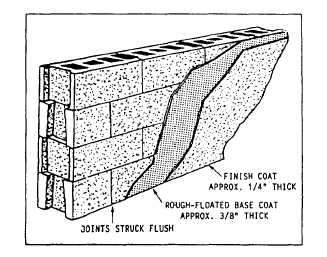float, after which the steel trowel is used. To avoid
excessive drawing of fines to the surface, delay
troweling of the portland cement-sand as long as
possible. For the same reason, the surface must not be
troweled too long.
The steps in float finishing are about the same as
those described for trowel finishing except, of course,
that the final finish is obtained with the float. A surface
is usually floated twice: a rough floating with a wooden
float first, then a final floating with a rubber or carpet
float. With one hand the plasterer applies with the brush,
while moving the float in the other hand in a circular
motion immediately behind the brush.
Special Textures
Some special interior-finish textures are obtained
by methods other than or in addition to floating. A few
of these are listed beow.
STIPPLED.— After the finish coat has been
applied, additional plaster is daubed over the surface
with a stippling brush or roller.
SPONGE.— By pressing a sponge against the
surface of the finish coat, you get a very soft, irregular
texture.
DASH.— The dash texture is obtained by throwing
plaster onto the surface from a brush. It produces a fairly
coarse finish that can be modified by brushing the
plaster with water before it sets.
TRAVERTINE.— The plaster is jabbed at random
with a whisk broom, wire brush, or other tool that will
form a dimpled surface. As the plaster begins to set, it
is troweled intermittentl y to form a pattern of rough and
smooth areas.
PEGGLE.— A rough finish, called peggle, is
obtained by throwing small pebbles or crushed stone
against a newly plastered surface. If necessary, a trowel
is used to press the stones lightly into the plaster.
STUCCO
LEARNING OBJECTIVE: Upon completing
this section, you should be able to identify the
composition of stucco, and state the procedures
for mixing, applying, and curing.
“Stucco” is the term applied to plaster whenever it
is applied to the exterior of a building or structure.
Stucco can be applied over wood frames or masonry
structures. A stucco finish lends warmth and interest to
projects.
Figure 7-18.—Masonry (two-coat work directly applied).
COMPOSITION
Stucco is a combination of cement or masonry
cement, sand and water, and frequently a plasticizing
material. Color pigments are often used in the finish
coat, which is usually a factory-prepared mix. The end
product has all the desirable properties of concrete.
Stucco is hard strong, fire resistant, weather resistant,
does not deteriorate after repeated wetting and drying,
resists rot and fungus, and retains colors.
The material used in a stucco mix should be free of
contaminants and unsound particles. Type I normal
Portland cement is generally used for stucco, although
type II, type III, and air-entraining may be used. The
plasticizing material added to the mix is hydrated lime.
Mixing water must be potable. The aggregate used in
cement stucco can greatly affect the quality and
performance of the finished product. It should be well
graded, clean, and free from loam, clay, or vegetable
matter, which can prevent the cement paste from
properly binding the aggregate particles together.
Follow the project specifications as to the type of
cement, lime, and aggregate to be used.
APPLICATION
Metal reinforcement should be used whenever
stucco is applied on wood frame, steel frame, flashing,
masonry, or any surface not providing a good bond
Stucco may be applied directly on masonry.
The rough-floated base coat is approximately
3/8 inch thick. The finish coat is approximately 1/4 inch
thick. Both are shown in figure 7-18 applied to a
masonry surface. On open-frame construction
7-16

